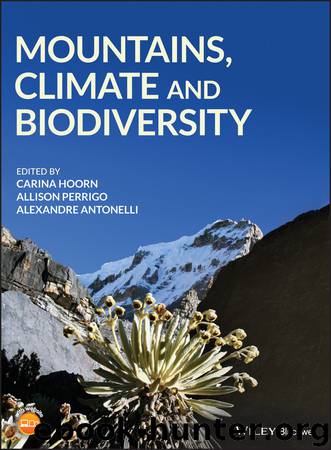Mountains, Climate and Biodiversity by Carina Hoorn & Allison Perrigo & Alexandre Antonelli

Author:Carina Hoorn & Allison Perrigo & Alexandre Antonelli
Language: eng
Format: epub
ISBN: 9781119159889
Published: 2018-05-07T00:00:00+00:00
16
The Interplay between Geological History and Ecology in Mountains
Catherine H. Graham1,2, Mauricio Parra3, Andrés Mora4 and Camilo Higuera4
1 Stony Brook University, Stony Brook, NY, USA
2 Swiss Federal Research Institute WSL, Birmensdorf, Switzerland
3 Institute of Energy and Environment, University of Sao Paulo, Brazil
4 Ecopetrol, Exploration Division, Bogota, Colombia
Abstract
Mountain biodiversity is strongly influenced by the geologic and climatic history of a given mountain region. While this phenomenon has been long acknowledged, the rich history of mountains documented by geologists and climatologists is often poorly integrated with ecological and evolutionary hypotheses about the origin and maintenance of diversity. Here, we detail two main approaches for such integration: a broad correlative approach, where characteristics such as uplift age, area or heterogeneity from multiple mountains are related to biological diversity, and a detailed study of the climatic and uplift history of a single mountain system and its influence on diversity patterns, using the Colombian Andes as an example. When applying either approach, ecologists and evolutionary biologists should consider the different temporal scales of ecological/evolutionary and geologic processes. For instance, many ecological and evolutionary processes occur at scales of one to thousands of years, while geologic change occurs over millions of years. Hence, a mountain considered geologically dynamic might be quite stable from an ecological perspective. In the Andes, we found that some areas considered to be geologically dynamic – a result of both proximity to a tectonic boundary resulting in rapid uplift and constant erosion caused by high precipitation – had high biological diversity. However, other regions that did not have these characteristics also had high diversity, implicating other mechanisms in the generation and maintenance of diversity. Based on our results, we suggest that while generalizations about how mountain history influences biological diversity are beginning to emerge, expected relationships are not always found, suggesting that much more can be learned by a careful integration of geology and climate utilizing ecological and evolutionary approaches.
Keywords: Andes mountains, Colombia, erosion, stability, topographic complexity
Download
This site does not store any files on its server. We only index and link to content provided by other sites. Please contact the content providers to delete copyright contents if any and email us, we'll remove relevant links or contents immediately.
Man-made Catastrophes and Risk Information Concealment by Dmitry Chernov & Didier Sornette(4749)
The Revenge of Geography: What the Map Tells Us About Coming Conflicts and the Battle Against Fate by Kaplan Robert D(3602)
Zero Waste Home by Bea Johnson(3297)
COSMOS by Carl Sagan(2959)
In a Sunburned Country by Bill Bryson(2953)
Good by S. Walden(2920)
The Fate of Rome: Climate, Disease, and the End of an Empire (The Princeton History of the Ancient World) by Kyle Harper(2443)
Camino Island by John Grisham(2391)
A Wilder Time by William E. Glassley(2367)
Organic Mushroom Farming and Mycoremediation by Tradd Cotter(2314)
Human Dynamics Research in Smart and Connected Communities by Shih-Lung Shaw & Daniel Sui(2181)
The Ogre by Doug Scott(2120)
Energy Myths and Realities by Vaclav Smil(2066)
The Traveler's Gift by Andy Andrews(2017)
Inside the Middle East by Avi Melamed(1946)
Birds of New Guinea by Pratt Thane K.; Beehler Bruce M.; Anderton John C(1915)
Ultimate Navigation Manual by Lyle Brotherton(1770)
A History of Warfare by John Keegan(1723)
And the Band Played On by Randy Shilts(1620)
